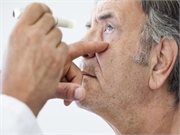Men have better best-corrected visual acuity than women; cataract more prevalent in women
FRIDAY, Feb. 7, 2020 (HealthDay News) — For older adults, low-contrast sensitivity is a predictor of experiencing poor vision, according to a study recently published online in Acta Ophthalmologica.
Lena Havstam Johansson, from the University of Gothenburg in Sweden, and colleagues examined vision-related quality of life, visual function, and predictors of poor vision in a population of 70-year-olds. Ocular morbidity and responses to the National Eye Institute Visual Functioning Questionnaire-25 (NEI VFQ-25) were self-reported for 1,209 individuals; results were included from ophthalmic examination in 560 individuals.
The researchers found that cataract, age-related macular degeneration (AMD), glaucoma, and diabetic retinopathy were the most common self-reported ophthalmic morbidities (23.4, 4.7, 4.3, and 1.4 percent, respectively). In women, cataract was more prevalent. For the entire cohort, the composite score from NEI VFQ-25 was 91.4; lower scores were seen with cataract or AMD. Best-corrected visual acuity (BCVA) was normal in 98.9 percent, while two individuals had low vision. Better BCVA was reported for men than for women. Visual field defects were observed in 16.3 percent of participants; 61.5 percent had uncorrected refractive errors. Overall, 7.4 percent of participants with presenting visual acuity (PVA) of ≥0.5 had poor vision, while 66.7 percent with PVA <0.5 had good vision. A significant predictor of experiencing poor vision was low-contrast sensitivity; PVA and visual field defects were not found to be predictors.
“This study provides knowledge on subjective and objective vision in normal ageing, which may contribute to improved health care for older persons,” the authors write.
Copyright © 2020 HealthDay. All rights reserved.








